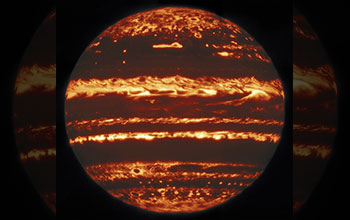Multimedia Gallery
Entire disk of Jupiter in infrared light
This image showing the entire disk of Jupiter in infrared light was compiled from a mosaic of nine separate pointings observed by the international Gemini Observatory on May 29, 2019.
How this image was created
Using a technique called "lucky imaging" -- where a large number of very short exposure images are obtained and only the sharpest images, when the Earth’s atmosphere is briefly stable, are used -- researchers obtained a set of 38 exposures taken at each pointing. Of these, the research team selected the sharpest 10%, combining them to image one-ninth of Jupiter’s disk. Stacks of exposures at the nine pointings were then combined to make one clear, global view of the planet. Even though it only takes a few seconds for Gemini to create each image in a lucky imaging set, completing all 38 exposures in a set can take minutes -- long enough for features to rotate noticeably across the disk. In order to compare and combine the images, they are first mapped to their actual latitude and longitude on Jupiter, using the limb, or edge of the disk, as a reference. Once the mosaics are compiled into a full disk, the final images are some of the highest-resolution infrared views of Jupiter ever taken from the ground.
[Research supported by U.S. National Science Foundation grant AST 1637494.]
Learn more in the NOIRLab news story Gemini gets lucky and takes a deep dive into Jupiter’s clouds. (Date image taken: 2020, based on observations from May 2019; date originally posted to NSF Multimedia Gallery: Aug. 7, 2020)
Credit: International Gemini Observatory/NOIRLab/NSF/AURA; M.H. Wong (UC Berkeley) and team acknowledgments: Mahdi Zamani
Images and other media in the National Science Foundation Multimedia Gallery are available for use in print and electronic material by NSF employees, members of the media, university staff, teachers and the general public. All media in the gallery are intended for personal, educational and nonprofit/non-commercial use only.
Images credited to the National Science Foundation, a federal agency, are in the public domain. The images were created by employees of the United States Government as part of their official duties or prepared by contractors as "works for hire" for NSF. You may freely use NSF-credited images and, at your discretion, credit NSF with a "Courtesy: National Science Foundation" notation.
Additional information about general usage can be found in Conditions.
Also Available:
Download the high-resolution JPG version of the image. (843.3 KB)
Use your mouse to right-click (Mac users may need to Ctrl-click) the link above and choose the option that will save the file or target to your computer.

